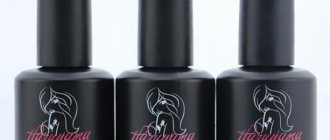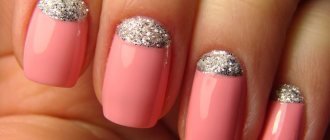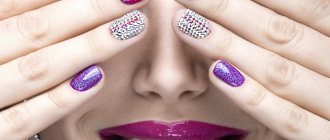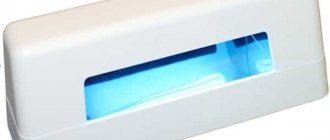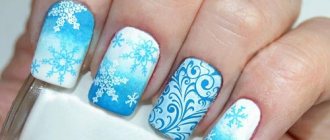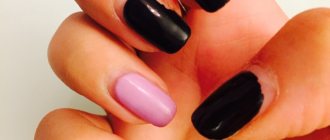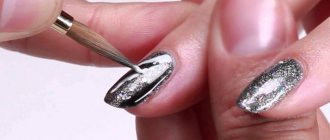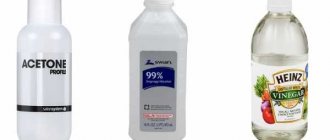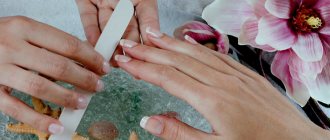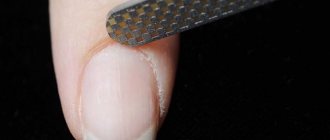What is a gel polish topcoat?
Top or finish, fixer, top coat is the top coat, the third phase in a three-phase system, the final stage in the procedure of applying gel polish to nails. First, the nails are covered with a base coat, then with colored gel polish and finally a top coat is applied. Each layer is polymerized separately. The finish is applied in a thin layer or with a slight leveling of highlights, but it is never used to strengthen the nails. Sometimes a design is made on top of the finishing coating, for example - gel modeling, three-dimensional painting, convex decor, loose glitter, etc.
How to use at home
Unlike topcoat, uv gel varnish does not require additional equipment for drying. In most cases, the fix already has a drying agent, that is, an additional component that promotes rapid drying. Within a minute you can safely begin your normal activities.
To fix the varnish at home, just unscrew the bottle of the product and apply a thin layer of finish. If the composition is not very thick, then the procedure should be repeated. For a dense base, one layer is enough.
What types of nail tops are there?
Classification of finishing coatings is made on several grounds, that is, on a number of unrelated characteristics. They affect the speed and ease of working with the material, the application technology and the range of tasks to be solved. The most important signs are:
- Glossy top or matte;
- With or without residual sticky layer;
- Elastic or hard;
- Thick or liquid;
- Turns yellow or blue;
- Whether it bubbles or not;
- Resistant to damage and rubbing or not;
- Specialized or general purpose;
- Decorative top or classic fixative.
The main functions of nail polish fixer
Even the best nail polish, which at first looks perfect on a manicure, loses its aesthetic appearance after a couple of days, and only a nail polish fixer can extend the life of the appearance of the manicure. The important functionalities of the varnish fixer include the following: - make the plate glossy; — keep the surface in its original condition for a long time; — prevent damage to the plate; - help the base dry; — saturate the horny plate with vitamins. All these functions are performed only by a high-quality finishing coating, so the choice of cosmetic product should be approached with all responsibility.
Glossy and matte top: is there a difference in application?
Classic fixatives in the gel system have a glossy shine. Manufacturers are competing for the hearts of craftsmen, developing materials with an ever brighter and more durable gloss. The brighter the gloss and the smoother the highlight, the more expensive the manicure looks. Therefore, clients often choose the specialist whose coating shines better and lasts longer.
A few years ago, matte tops . And here, too, a wide choice is provided - the degree of matte varies from a smooth satin shimmer to the velor effect of an anti-slip surface. You can find names like these: satin, velvet, corduroy, velor, cashmere.
The nuances of using a matte finish. How to properly apply matte top over gel polish
- Often this finish serves only a decorative function. Therefore, before applying it, for reliability, it is better to cover the nails with a regular gel polish fixer with residual stickiness, dry, remove the stickiness and apply a layer of matte top;
- Matte finishes actively absorb dyes and fats, rub off and begin to shine after just a week of wear, so they require care. They are not suitable for colorists, chefs, artists and anyone whose hands are subject to heavy workload. If the matte top gets dirty, you can clean it with a cotton pad soaked in alcohol. Do not use acetone, it will dissolve the gel polish.
- The more velvety the matte top, the more it feels on your hands, like it’s “braking” the entire surface. For girls with high sensitivity, we recommend choosing satin tops - they will provide a fashionable lack of gloss and will not irritate.
How to strengthen nails under gel polish with acrylic powder?
In addition to this method, strengthening is often carried out using a base containing acrylic powder. In this case, acrylic acts as a kind of reinforcement, that is, it builds a kind of strong frame.
Instructions:
- To carry out this manipulation, the preparation of the nail plate is carried out in a standard way; a thin rubbing layer of base is applied, which must be dried in a lamp. After this, a thick layer of base is applied and sprinkled with acrylic powder.
- After this, the mixture is dried in a lamp without removing the sticky layer; another leveling layer of the base is applied, which will help hide the grains of acrylic if they are large.
- This method is suitable for nails of medium strength, and will not save you from chipping gel polish if your nail plate is very thin, weak, or flaking.
Camouflage base
Finish with or without tack. What is the difference
“Sticky” - the dispersion layer consists of material components that were not included in the polymer and did not evaporate in the lamp, but remained on its surface.
Tops for gel polish with a sticky layer
Classic gel polish finishes - soak off top coat, finish gel. In conventional topcoats, the dispersion is not sticky, but rather slippery, it has no functional load and must be removed.
Do not wipe off the sticky layer as soon as you remove your hand from the lamp - let the top cool a little. Otherwise, you can leave unsightly marks from the napkin on the hot surface.
The dispersion should be washed off carefully, without smearing it on the skin around it. For each nail, use a clean, lint-free tissue or the unused side of it.
After moistening it in liquid to remove the sticky layer or in alcohol, apply the napkin to the surface of the nail for a couple of seconds and remove it towards you. Due to such careful removal of the dispersion, the risk of allergies is reduced.
In specialized finishes, for example, tops for sliders, the dispersion can be very sticky - it helps to fix the decor and is preserved by covering it with another layer of a regular finish on top.
Gel polish tops without sticky layer
Widely used family of finishing coatings. No wipe top coat, no cleanse top coat, non-cleansing gel top, finish gel without sticky layer, top without l/s - all these are variants of the names of the material, all components of which are part of the final polymer, without the formation of a dispersion layer on the surface.
The no-tack finish has a brighter shine and is quicker to apply as there is no time required to remove the dispersion. Previously, such materials were considered fragile, but thanks to the development of technology, this problem has gone away. The main thing is not to overdry them much longer than the time recommended on the bottle, since with every minute in the lamp they become more compacted and stretched. You can safely choose them as the main fixative and enjoy the acceleration. Also, rubs are rubbed into such tops, broths and voluminous decor are secured with them.
Types of fixatives
There are a huge number of types of nail polish fixer. They all differ not only in composition, but also in form. Let's look at the most current features of the product that helps fix the coating with decor.
By composition
An integral material for working with manicure exists in several variations. At first glance, it may seem that all bottles with clear liquid are the same, but this is far from the case.
There are several types of fixative:
- Classic option. Usually comes without a sticky layer, requires additional drying.
- Thick fixative. It has a dense consistency and has an increased protective effect against chips, cracks, scratches and fading. Perfectly strengthens manicure and all nails in general.
- Glossy finish. The product is not always transparent, and even a little cloudy. Creates a soft and pleasant gloss effect on nails.
- Matting. Helps reduce the brightness of the coating and gives it a special and noble matte effect.
- Fixative with biological additives. It contains natural ingredients that strengthen and heal the nail plate. Not suitable for extended nails.
By properties and form
Finish coatings also differ in properties:
- For regular varnishes. The product is suitable for treating nails that are painted with the most common varnishes. This coating lasts about 5-7 days.
- For fixing gel polishes. The gel polish top helps protect your manicure for 2-3 weeks. It must be dried in a lamp for 30 seconds to 3 minutes, like the entire gel polish system.
If we talk about the form of fixatives, there are several of them:
- glass bottle with brush;
- spray;
- liquid form with pipette.
An overview of the best nail polish fixers can be seen in the video.
The best manufacturers
For you, we have collected popular products that have been tested not only by time, but also by a huge number of nail art masters. What is the best way to choose a nail polish fixer?
| Manufacturer | average price | Characteristics |
| Orly | 700-900 rubles | A professional finishing coat creates a dense protective layer for your nail design. It makes the varnish dry much faster. |
| Kapous | 500-600 rubles | The manufacturer has a huge number of varnish fixatives. All of them perfectly protect the manicure, create perfect highlights and add depth to the coating. |
| Relouis | 200-350 rubles | The brand creates both classic fixers and sprays for the nail plate. They perfectly protect nails from mechanical damage. |
| Glos Top Coat | 160-250 rubles | The product has medium thickness. The product protects nails for 5-7 days, but gives a special unique shine. |
| RuNail | 280-360 rubles | The fixative has a convenient brush, thanks to which the product lies in an even layer on the nails. Protects well from chipping and delamination. |
| Kodi | 270-330 rubles | An excellent and relatively inexpensive solution for creating and securing your coating. Ideally fits on nails and protects them. |
Fixer for gel polish: hard or elastic
Just like the base, the finish gel can have varying degrees of elasticity. Hard, rigid fixatives - hard top - can only be applied to artificial nails reinforced with hard materials or extended ones. If the base is soft and the top coating is hard, then with use it will crack like chocolate icing on jelly. Cracks and chips will appear, which will trap dust and dirt, which will greatly ruin the aesthetics.
Stretch tops are more versatile than hard tops as they can be applied to any surface. If you don’t know whether your finish is hard or plastic, you can check it this way: apply a strip of material to the film, polymerize it, separate it from the film and try to bend it. The hard one will break, the elastic one will crumple.
Learning to choose a quality fixer
The quality of the fixative plays a very important role, since a poor product is not always able to perform the necessary functions. First you need to pay attention to the composition. If ingredients such as vitamins A, E (B) and protein are not listed there, then most likely it is a fake or an obviously unsuccessful product.
You can learn a lot about the chosen fixative during the first “crash test” in the form of application. A good product will keep your manicure on your nails for at least six days with proper care. If after some short time the layer of fixative begins to crack, turn yellow or lose its shine and other properties, its place is probably not in a cosmetic bag, but, alas, in the trash bin.
Editor's choice: How to make a stylish French manicure on short nails
If stores provide testers to their customers, then it is better to start checking products not after purchase, but right on the spot. The presence of such obvious defects as uneven application and bubbles indicates disgusting quality. The fixative should not be too liquid and spread across the nail onto the skin or be applied in streaks.
Another sure sign of quality is the glossy finish. Because matte fixatives simply do not exist. The finished manicure should shine without any distortion or blemishes.
Liquid or thick top. Which one for what
Liquid top for gel polish
Forms a drop on the brush in 1-2 seconds. Self-levels quickly, lays down in a thin layer and is suitable for experienced craftsmen who save time. Not suitable for fixing voluminous decor such as bouillons, rhinestones and studs. Beginners and those who apply the coating themselves often experience problems with leakage into the nail cavity.
Medium consistency top coat for gel polish
It forms a drop in 3-5 seconds. It is applied in a medium thickness layer and self-levels well. It can be called universal, as it is easy to use at any level of skill, on nails of any length and volume.
Thick top for gel polish
Forms a drop on the brush in 6-8 seconds. It is applied in a fairly thick layer, at least 0.5 mm, which adds volume to the coating and takes a long time to self-level. As a main fixative, it is interesting for complete beginners with no experience, as it does not spread and is suitable for slow motor skills. Experienced craftsmen use it to secure rhinestones, bouillons, studs, and for local application.
Difference between the product and clear varnish
Quite often, nail hardener is confused with regular clear varnishes. But it is worth remembering that these are 2 completely different products. The transparent base does not have all the properties that the fixative does. A regular manicure coated with a clear liquid can quickly become damaged, peel, and will not last long. In addition, a manicure coated with regular clear varnish will take a very long time to dry.
The effectiveness of the fixative is often underestimated. But the top coat has many beneficial properties, which makes it indispensable for those who want to have healthy, strong and beautiful nails. If you do a manicure not in a salon, but at home, then using a fixer is necessary. The use of such products is also necessary when covering manicures with gels. The gel polish fixer has a number of strong protective functions. It does not allow the gel polish to crack or peel off in layers and guarantees that the girl will have a beautiful and elegant manicure for a long time.
In addition, it is the fixative that helps any nail art look finished. For lovers of complex designs, this product is a must-have. After all, it helps to smooth out all the unevenness of the manicure, fill the gaps between the designs on the plate, adds shine, and your design will remain in its original form for a long time. Some sealants can be applied to a base that is not yet completely dry. This will contribute to better fixation and faster, better drying.
The gel polish top turns yellow or blue. Which finish to choose for black and which for white?
Any topcoat can turn yellow, regardless of the signs described above. Typically, yellowing becomes noticeable when applying a leveling finish over a light gel polish, when thickness appears. Yellowness can be either an intrinsic property of the material or the result of pigments from bright gel polish entering it. So, when red shades overlap, residual color dispersion gets onto the top brush, and as it accumulates in the bottle, the transparent material acquires a yellowish tint. This happens approximately in the second half of the bottle. We recommend wiping your brush after bright colors or getting a separate bottle of finish for light shades.
The “blue” finish is usually the opposite, on dark and bright colors and only in natural light, which contains ultraviolet light. This is due to the presence of UV filters in the material. Black gel polish can turn blue under bright sunlight, brown - purple, scarlet - crimson, etc. Therefore, for dark shades, we recommend choosing a top without UV filters. Whether it turns yellow or not does not matter.
For the cleanest and freshest jacket possible, as well as white and all light shades, get a strong blue top with UV filters. For example, without l/s: Bagheera Nails B-5 Lite or Uno Supershine. For black, dark and bright colors, choose a top without a UV filter, which may yellow slightly - it will not be noticeable. For example, top with l/s NeoNail Hard Top.
The gel polish top is bubbling. Who is to blame and what to do
Air bubbles in gel polish are a serious problem, since they do not disappear during polymerization and look sloppy on the surface of the material, like garbage. They appear due to sudden movements of the brush in the bottle, forcing air into the material. If you do not want to have aesthetic defects in the coating, then get used to smooth and neat, precise movements. Do not throw the brush into the bottle, do not shake the gel polish, do not stir it right before use.
There are materials that are more prone to the formation of bubbles; you should be extremely careful with these. There are less sensitive exceptions, but even with them you should not allow yourself unnecessary sudden movements. Check for bubbles before polymerization and, if found, carefully burst each one. To do this, lightly poke the bubble with the tip of a thin brush or orange stick.
Using a fixative - how to preserve your manicure
For the durability of the coating, it is very important to properly prepare the nail and pre-apply the base before the main varnish. But it is also necessary to use the fixative correctly to get the maximum benefit from it.
If the product is incompatible with a wet base, then you must first wait until the manicure dries thoroughly. And only after that start applying a fixative to it.
It is advisable to apply it in three light movements, starting from the center and then sequentially and carefully working on the sides. Try to apply it in a thin layer. It dries quickly, while a thick one may not dry at all, making the manicure soft and damaged.
Editor's choice: Painting your nails with fashionable polish colors: fashion trends 2022
The procedure can be considered complete when the fixative has completely set and dried. After which you will be able to enjoy the results of your labors for at least a week. And with careful handling of nails - even more. In the case of gel polish, the original appearance of the manicure is easily preserved for 20-30 days.
But that's not all. This time can be increased if you periodically adjust the manicure, renewing the fixative layer 4 days after the start of the previous application.
Gel polish top is rubbed off
Absolutely any top will be rubbed off . Glossy becomes matte, and initially matte begins to shine over time. Finish coatings from the premium segment retain an attractive appearance for up to 4 weeks of wear, while cheap ones can lose it after just a couple of days. This process occurs most quickly on the nails of the working hand: for right-handers - on the right, for left-handers - on the left. On the thumb, index and middle fingers. You can slow down the loss of appearance by strengthening your nails with hard materials: gel, acrygel, hard base. This will make the free edge motionless, which means it will bend and rub less. Strengthening will also prevent cracks, chips and detachments.
Fixer and clear varnish
One of the most common misconceptions is that nail polish sealer is just regular clear nail polish “by another name.” Although in fact these are two completely different products in composition and properties.
Regular varnish without colored pigment is not able to protect the finished manicure. In addition, it will most likely take a long time to dry and, on the contrary, will increase the likelihood that the design on the nails will be damaged: it can become smeared or damaged from the slightest impact, it will be erased or quickly become chipped and will almost certainly begin to peel off.
Special purpose finish
NeoNail Top for Slider and Pole thick top for fixing volumetric decor
These topcoats are designed to secure the decor. They produce tops for sliders, for rubbing, for attaching rhinestones, bouillons, etc. All their properties are best selected to solve a specific problem. For example, the finish for fixing volumetric decor will be without a sticky layer, thick and as transparent as possible. The slider top will be medium thick, with a very sticky dispersion and a little yellowish (which is okay). Typically, such coatings are not used as basic and universal ones.
Decorative tops for gel polish
Decorative gels include finishing gels, to which manufacturers have carefully added various decorative elements. For example, there are both glossy and matte finishes, which contain a variety of glitter, yuca flakes, magnetic cat-eye pigment, different-sized white and black flakes to create the effect of a quail egg, reflective particles, dried flowers, gold leaf, mother-of-pearl, camouflage pigment, etc. We recommend checking how even and smooth the surface of such a top coat polymerized on the nail is. If decorative elements protrude, then it is better to lightly go over the surface with a buff, degrease and cover with another layer of your usual, favorite topcoat.
Frequently asked questions or FAQ for beginners
Which top coat for gel polish is better?
The one that is more convenient to work with and copes with the tasks that you set for it. Uno Supershine is recognized by craftsmen as almost universal: without a sticky layer, elastic, medium in thickness, has a bright gloss, rubs off slowly, does not bluish much, does not yellow much, does not bubble, dries quickly, you can rub rubs into it and fix small decor with it.
Why does the top fit with bald spots?
There are several reasons for this. This often happens when covering with a top coat without l/s in two layers, or applying it over a gel paint without l/s, or when applying a matte finish to a finish without l/s. This may also be due to sebum or cosmetics getting on the surface to be coated - degreasing it with nail prep will help. Or the colored gel polish you are applying the top on has too much greasy dispersion - then remove the sticky layer and try again. Or, on the contrary, the color/paint/finish has no dispersion and the material rolls off a too smooth surface - then lightly buff the color to make roughness appear. And also, one should not rule out simply the low quality of the material, especially purchased from Chinese online stores.
Is it possible to apply gel polish and gel paint to the top?
Can. But it is better to choose a top coat with residual stickiness for such techniques, remove the stickiness and paint on top with gel polish or gel paint in a not too thin layer, otherwise chips are possible. If you need to completely cover the finish on top with colored gel polish, then first buff it, degrease it, and then cover it. And cover the top again with a layer of sealer.
Rubber top for gel polish. What is it and why
These are very thick materials with good adhesion. They are suitable for fixing volumetric decor, but are not convenient for completely covering nails, as they spread slowly and self-level.
Is it possible to use a top instead of a base?
No need. These materials are created to solve different problems. The base ensures adhesion to keratin, strengthening the natural nail, and the finish fixes the color and prevents it from fading in the sun and rubbing off under mechanical stress. They are not interchangeable.
Hypoallergenic top for gel polish
Any artificial material can cause allergies. Its risk can be reduced due to its quality and lack of contact with the skin. Choose a top without residual dispersion from the premium segment.
How to replace top coat for gel polish
Single-phase transparent gel (it will be hard) or single-phase 3 in 1 gel polish. In a three-phase system, base, color and top are not interchangeable.
What it is
Nail polish fixer is a colorless transparent liquid that protects the coating and decor on your fingers for a long time. This is a real must-have for women's cosmetics bag. It is a top or finishing coat that is always applied to the finished manicure. The fixative lays down as an even thin transparent film on the nail plate and, after drying, gives it a special shine.
The product perfectly strengthens all layers of varnish and speeds up the polymerization time. But these are not its only functions. The product nourishes and strengthens the nail plate well, gives it additional stability, protects it from temperature changes, delamination and any mechanical stress.
Nail polish fixer can be applied even if the base is not completely dry.
The product can also be used in complex decoration. When a special layer is needed to draw some elements and complex designs or to fix rhinestones, modeling and other decor, then a nail polish fixer will come to the rescue. The transparent product perfectly fills the empty areas between rhinestones, bouillons, and sequins. It is with it that the final composition looks luxurious and has a special shine.
Compound
The product is available in a glass jar with a special lid with a brush. In its composition it resembles a regular transparent varnish. Each fixative manufacturer has its own secret formulas during production. The composition can vary dramatically, depending on what functions the product performs.
But, nevertheless, we can identify a number of ingredients that are present in almost every varnish fixative:
- Nitrocellulose is responsible for the strength of the coating. It is able to protect nails from any damage and delamination.
- Elastic component. Most often it is a rubber or silicone concentrate that acts as a thickener. Thanks to it, the fixative becomes viscous and forms a dense film on the surface of the nail plate.
- Synthetic inclusions provide an ideal finish: glossy, matte, satin, matte.
- Biological ingredients help the product to attach securely to the nails. Typically, the components contain a lot of calcium, beneficial vitamins, trace elements and minerals.
Advantages and disadvantages
A good nail polish fixer has a number of pros and cons. Let's take a closer look at the positive aspects of the product:
- Protects the nail plate from any damage.
- Bonds all layers of varnish or gel polish.
- Strengthens and saturates the shade of nail design.
- Covers nails with a thick glossy or matte film.
- Extends the wear time of manicure to several weeks.
- Suitable for fixing rhinestones, bouillons, crystals and Swarovski stones.
- The gel nail polish fixer does not have a strong odor.
- Rubber tops are quite thick in consistency. Using them you can make three-dimensional compositions.
- Dries quickly.
- Easily applied to the entire nail using a brush.
But the product also has negative sides:
- Some low-quality brands dry out quickly if you leave the bottle open often.
- Sometimes poor quality fixative tends to curl.
- If you initially incorrectly prepare the nail plate for manicure, the product may come off as a film or peel off from it.
- If the application technology is incorrect, the finish coating may roll off.
- Some types of fixative require a special UV or LED lamp.
